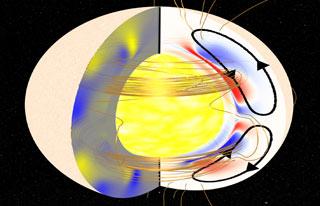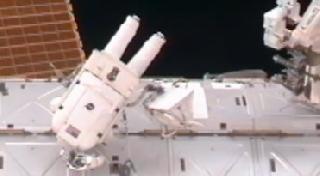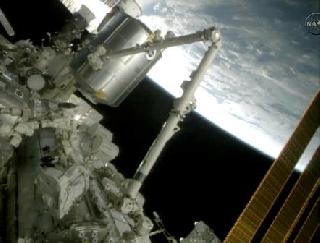
In this artistic cutaway view of the sun, the Great Conveyor Belt appears as a set of black loops connecting the stellar surface to the interior. Photo: Andr�s Mu�oz-Jaramillo of the Harvard CfA.
WASHINGTON (PTI): A joint research sponsored by India's top science body and NASA and done by a scientist from Kolkata has explained the "puzzle" of recent period of decreased solar activity during the Sun's 11-year cycle.
Solar scientists around the world were puzzled by the extended disappearance of sunspots in 2008-2009.
The recent solar minimum, a period characterised by a lower frequency of sunspots and solar storms, was the deepest observed in almost 100 years.
The solar minimum has repercussions on the safety of space travel and the amount of orbital debris our planet accumulates, a NASA release said.
"Plasma currents deep inside the sun interfered with the formation of sunspots and prolonged the solar minimum," said lead author Dibyendu Nandi of the Indian Institute of Science Education and Research in Kolkata.
Funded by NASA's Living With a Star Programme and the Department of Science and Technology (DST) of the Indian Government, the research revealed that during this deep solar minimum, the sun's magnetic field weakened, allowing cosmic rays to penetrate the solar system in record numbers, making space a more dangerous place to travel.
At the same time, the decrease in ultraviolet radiation caused Earth's upper atmosphere to cool and collapse, it said.
"This research demonstrates how observations from Heliophysics System Observatory missions stimulate new theories and advance modeling techniques," said Richard Fisher, director of the Heliophysics Division in NASA's Science Mission Directorate at the agency's headquarters in Washington.
The solar cycle, or the solar magnetic activity cycle, is a periodic change in the amount of irradiation from the sun that is experienced on Earth.
It has a period of about 10.7 years (approximately 11 years), and is one component of solar variation, the other being aperiodic fluctuations.
Solar variation causes changes in space weather and to some degree weather on Earth. However, changes in solar brightness are too weak to explain recent climate change. The cycle is observed by counting the frequency and placement of sunspots visible on the Sun.
 Previous Article
Previous Article Next Article
Next Article













The Indian Air Force, in its flight trials evaluation report submitted before the Defence Ministry l..
view articleAn insight into the Medium Multi-Role Combat Aircraft competition...
view articleSky enthusiasts can now spot the International Space Station (ISS) commanded by Indian-American astr..
view article